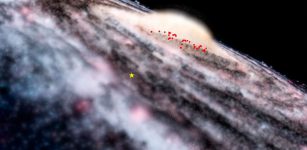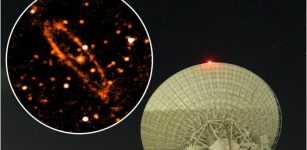Wobbly And Flared Milky Way Disk Based On LAMOST- Gaia Data
Eddie Gonzales Jr. – MessageToEagle.com – Astronomers from National Astronomical Observatories of Chinese Academy of Sciences (NAOC), Shanghai Astronomical Observatory of CAS and Nanjing University have revealed the wobbly and flared nature of the Milky Way disk based on LAMOST-Gaia data, which updates our understanding about the galaxy.
Milky Way. Image credit: Nick Risinger – source
The Milky Way is a typical disk galaxy. In the classical view of the Milky Way, the disk is symmetric and flat on the whole, like a pancake. Stars in the disk rotate around the galactic center, with mean radial and vertical velocities to be zero.
With the help of huge observational data provided by large survey projects in recent years, more and more details hidden in the Milky Way disk have become apparent, casting doubts on the traditional imagination about our host galaxy.
“The huge number of spectra obtained by LAMOST and the high-precision astrometric data released by Gaia provide a golden opportunity for re-exploring the disk structure,” said Prof. Zhao Gang, the corresponding author of the work.
Led by Dr. Ding Pingjie, the first author of the work, the researchers selected ~490,000 K-type giants from LAMOST DR8 and Gaia EDR3 as tracers. They found that in the spatial range of Galactocentric radius of 5–15 kpc and 3 kpc above and below the galactic plane, vertical wobbles existed in the three-dimensional mean velocities.
Contrary to the classical picture that stellar motions keep symmetric about the galactic plane, the K-type giants below the plane are found to rotate faster than those above. Meanwhile, inner disk stars migrate radially toward the outer disk, while outer disk stars exhibit alternate inward and outward radial motions, with velocities highly dependent on the vertical distance.
Moreover, a contraction-like breathing mode and an upward bending mode dominate the vertical motion of the outer disk. By comparison, there is only a weak rarefaction-like breathing mode and a trivial downward bending mode in the inner disk.
The researchers further revisited the nature of the disk flaring by estimating the scale height of the disk with the measured velocity ellipsoid. They found that the scale height increased obviously with the increasing galactocentric radius, leading to a flaring feature. The results also indicated that north and south disks had consistent flaring strength. Similar flaring structures were also detected in some external galaxies, which means that a flared disk could be a common phenomenon in disk galaxies.
The wobbly disk probed by the LAMOST-Gaia K-type giants could be attributed to the perturbations produced by both inplane substructures (including the spiral arms and the central bar) and long-lived external perturbers (such as a satellite galaxy). The mechanism behind the flaring structure still remains mysterious.
“This study provides high-quality clues to the galactic structure and evolution. Continuous observations will help to tell a more insightful story of the Milky Way,” said Xue Xiangxiang, the second author of the paper.
Written by Eddie Gonzales Jr. MessageToEagle.com Staff











